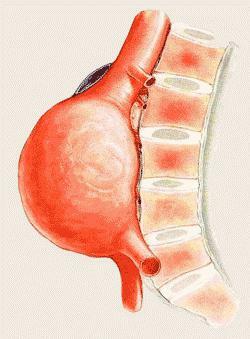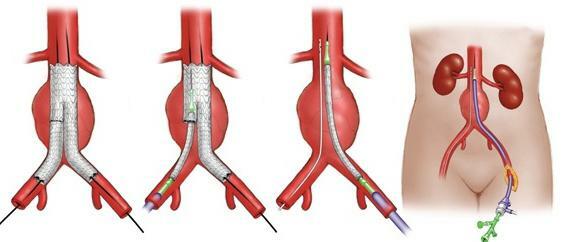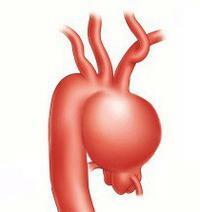Aneurysm of the aorta of the abdominal cavity: causes, symptoms and treatment
Aneurysm of the aorta of the abdominal cavity is a pathological thinning and protrusion of the wall of a given blood vessel. In a normal state arterial vessels are rather muscular and thick. This allows them to withstand severe pressure drops. But sometimes, in a certain area, the artery walls become thinner and inflate under the influence of internal pressure. This bulge is called an aneurysm. It can be formed on various vessels, however it is most often found in certain areas of the aorta, which is the largest artery in the body. For example, an aneurysm of the ascending aorta or its arches.

Internal walls of pathological formation are often covered with blood clots. Sometimes there is a protrusion of not the entire wall in a particular section of the vessel, but between its layers. Blood is filled with a cavity formed between the tissues of the artery. This pathology is called an exfoliating aneurysm.
Causes of a pathology
Aneurysm of the aorta of the abdominal cavity appears most often due to such reasons:
- chronic hypertension;
- weakening of the walls of the blood vessel, loss of their elasticity, atherosclerosis;
- age( senile) changes;
- congenital and hereditary abnormalities in the development of the body. A number of genetic abnormalities, such as Marfan syndrome, can cause weakness of arterial walls;
- local mechanical damage;
- is a common cause of the occurrence of thoracic aneurysms - syphilis and tuberculosis.
Symptoms and Diagnosis
Very often, the aortic aneurysm of the abdominal cavity is asymptomatic. In the presence of symptoms, this ailment is manifested as follows:
- strong pressing and "tearing" pain in the chest, abdomen or back - between the shoulder blades;
- sensation of pulsating mass in the region of the stomach;
- The thoracic aortic aneurysm of the abdominal cavity can cause hoarseness, dyspnea, difficulty breathing or swallowing( due to the pressure of formation on the esophagus, the airways and the lungs).
 It should be understood that the aortic aneurysm is a very dangerous pathology. Breaking it often leads to shock and death. Diagnosing this disease is difficult because of the asymptomatic course. Often it is found out by chance with outside research. An indirect sign of the presence of an aneurysm may be cardiac murmurs. Studies for the detection of pathology:
It should be understood that the aortic aneurysm is a very dangerous pathology. Breaking it often leads to shock and death. Diagnosing this disease is difficult because of the asymptomatic course. Often it is found out by chance with outside research. An indirect sign of the presence of an aneurysm may be cardiac murmurs. Studies for the detection of pathology:
- ultrasound( dopplerography);
- MRI;
- angiography with contrast agent;
- computed tomography.

Even relatively small aortic aneurysms require constant monitoring and control of changes.
Treatment of
The surgical method is the only means by which abdominal aortic aneurysm can be eliminated. The operation is performed to remove the weakened section of the artery and replace it with an artificial implant. If the pathology is close to the aortic valve, its endoprosthetics may be indicated. The operation to eliminate an aneurysm is very complex and requires the participation of surgeons-phlebologists of high qualification, however, ignoring this problem carries a much greater risk.
